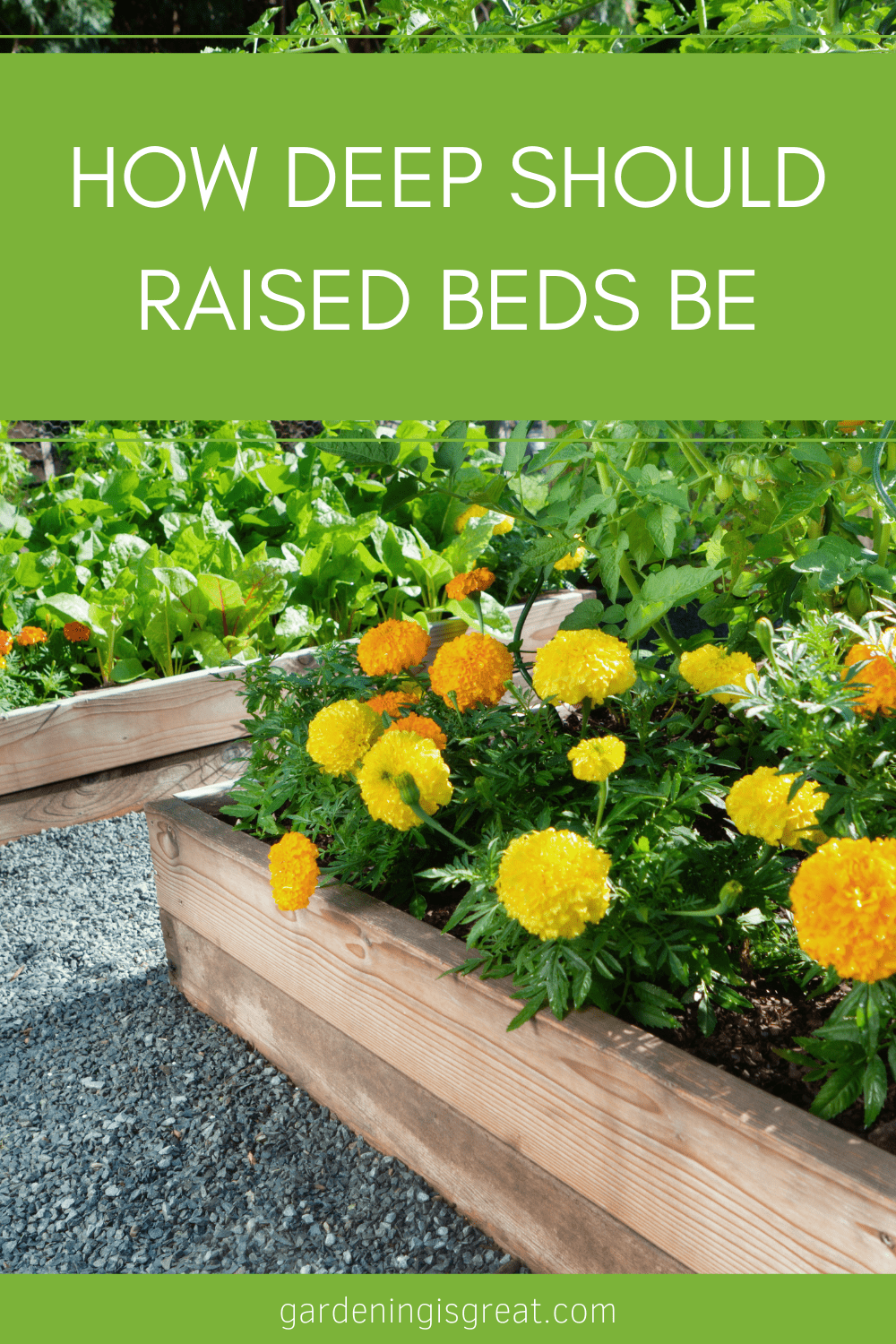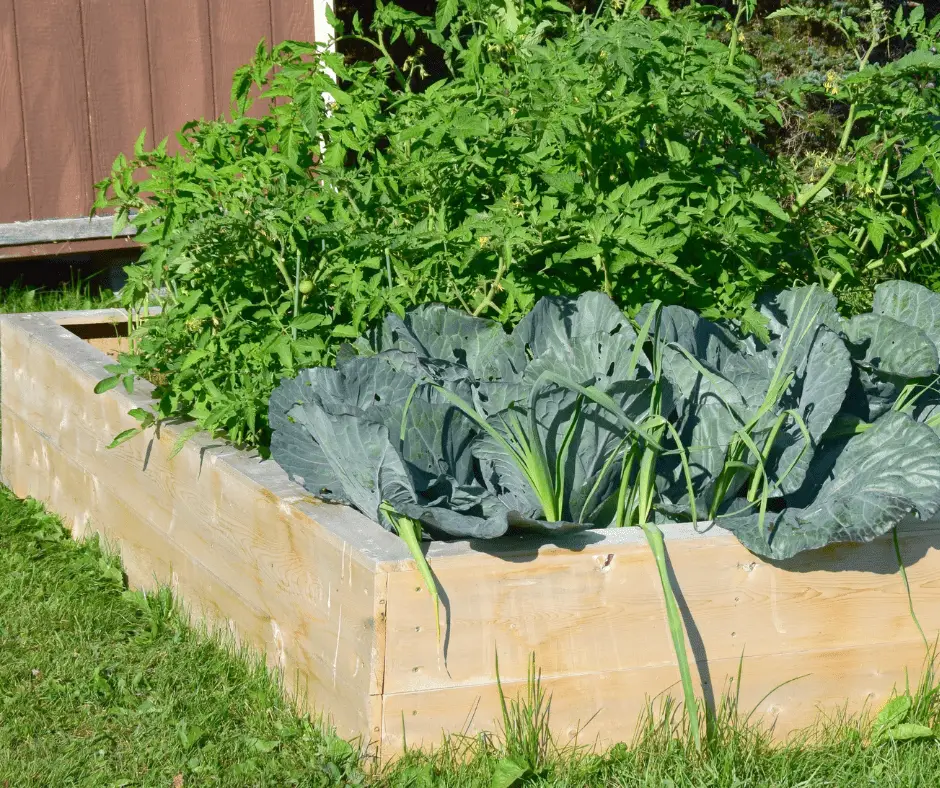How Deep Should A Raised Garden Bed Be?
Raised garden beds are a great option compared to planting directly in the ground for several reasons:
- They help reduce the risk of pests accessing your plants
- With a raised height, they are ideal for gardeners who are less mobile, elderly, or have back problems
- Raised beds can be easier to maintain and often have fewer weeds growing.
Knowing how deep your raised garden bed should be is a crucial decision to help provide your plants with the right growing conditions.
Too shallow, and your plants won’t have enough room to grow roots.
Too deep, and your raised bed may become too heavy and unstable causing it to bow and lack proper support for your plants.
This post will not only cover how deep your raised garden bed should be but also certain considerations you should be aware of first.

How Deep Should A Raised Garden Bed Be?
A raised garden bed should be no less than 11 inches deep. This is the same size as 2 6inch wooden boards which are most commonly used to build raised garden beds.
With that said, however, most plants, especially if you are considering growing vegetables, require at least 12 inches depth.
So 11 inches should be the bare minimum depth you should consider for your beds. Ideally, your beds will be at least double this amount. This takes into account:
- You need to leave a good inch from the top of your raised garden bed clear providing you with room to erect a cover and maintain your bed without creating an overflow of soil
- When it rains, if the soil level is too high the nutrients within the top soil will run off the sides of your garden beds.
By creating a deeper garden bed will benefit you not only physically to maintain higher beds, but will also benefit your plants. It enables them more space to create strong, supporting roots leading to healthier plants that can support themselves.
Things To Consider Before Creating A Raised Garden Bed
Before building your garden beds and knowing how tall and deep you want them to be, depends upon:
- What plants you are choosing to grow
- The materials you have selected
- What you would like to fill your raised beds with
- Where you choose to position your garden bed.
Let’s take a look at each consideration individually:
Choice of Plants
Depending on what you choose to plant will make a difference to how deep you need to make your raised garden beds.
If you are choosing to grow flowers, these generally do not require a deep amount of soil and do well in shallower raised beds. Quite often, flowers are grown in an unstructured raised bed. The soil has been moved into a mound, rather than materials used to build sides.
However, if you are growing crops such as vegetables, these do best in a structured raised garden bed and with deeper soil.
Even shallow-rooted vegetables such as broccoli, spring onions, or lettuce still need a deeper level of the soil. This is to help prevent them from being uprooted by strong winds.
For root vegetables, such as potatoes and carrots, as these primarily grow underground, you need to ensure there is a deep amount of soil not just for space but providing the right nutrients also.

Materials For A Raised Garden Bed
The average height of a raised garden bed is 11 inches, which is the same height as 2 6inch wooden boards. This is one of the most commonly used materials to build a raised garden bed and hence using these boards can help you to assess how deep you would like to build your beds.
As most vegetables require at least 12-24 inches of soil for their roots, it is recommended to use at least 3, 6inch wooden boards. This also helps raise the height of your garden beds for easier management and makes them less accessible to garden pests.
However, if you are choosing to use other materials such as stone, plastic, or concrete blocks, you may need to adjust the height of your beds according to the height of your materials.
Stone and concrete blocks are both heavy and would be challenging to safely stack on top of each other to increase the depth of your garden beds.
Plastic, on the other hand, is lightweight and can be purchased in a range of sizes to suit your needs.
So it is worth considering what materials you would like to use for your garden bed and whether or not they would be suited to the height you and your plants require.
Positioning and Filling Your Raised Garden Beds
The last two bullet points have been grouped as depending upon where you position your garden beds will often lead to what you need to fill your garden beds with.
Positioning On Top Of Soil
If you are building garden beds on top of your garden soil, it is recommended to dig at least 2 spades deep first. Firstly, this helps remove any unwanted weeds you may have missed from the topsoil. Secondly, it ensures that no tree roots are growing where you want to position your raised garden beds. Thirdly, it enables you to assess the quality of the soil and what might need adding to improve the nutrients or drainage.
Once this initial digging has been completed, you can erect your raised garden bed and fill it with a mix of the soil you dug from your garden and nutrient-rich compost.
This will help ensure your plants get off to a good start but also helps to improve water drainage.
Positioning On Top Of Concrete / Patio
If positioning your raised garden beds on top of a patio or concrete, you have the bonus of not having to dig the current soil in your garden.
However, weeds can still grow between your concrete slabs and infiltrate your raised garden beds – which you don’t want!
You can avoid this by placing a barrier between the bottom of your garden beds and the added soil. It is recommended to add a layer of natural, organic material that will turn to compost such as leaves, cut grass, or straw. Then place large pieces of cardboard on top to prevent weeds from growing and reaching your garden beds.
Now, you can add nutrient-rich compost mixed with sand to ensure good drainage for excess water.

By following these considerations along with the recommended depth, you should be able to build raised garden beds that support your plants and provide them with the space and nutrients they need to grow healthy and strong.
Raised garden beds aren’t just beneficial for your plants, but also for you too. They minimize having to bend down as low in order to tend to your plants. This is ideal if you are someone who struggles with mobility or is an elderly gardener. Raised beds also help to make it easier to maintain your plants, lowering the number of weeds and potential pests.
For more top tips on using raised garden beds in your garden, take a look at these popular posts:
